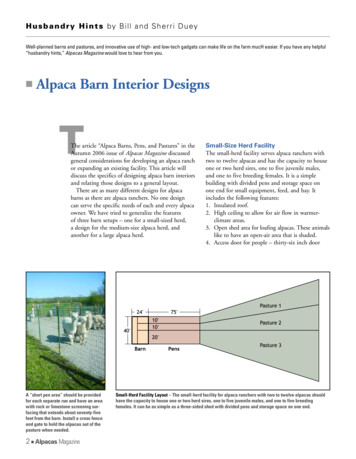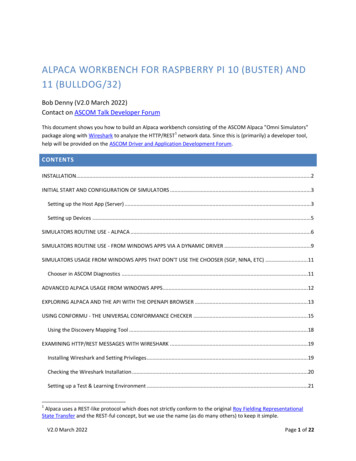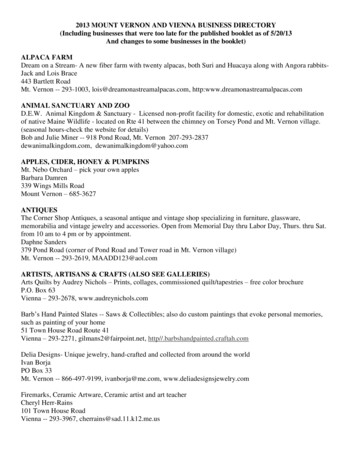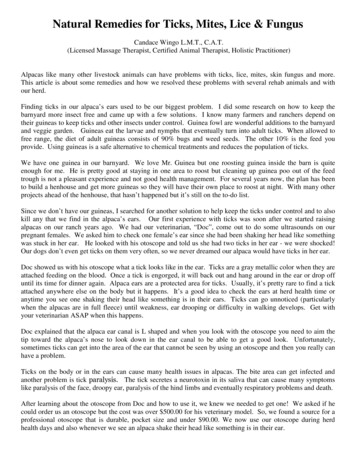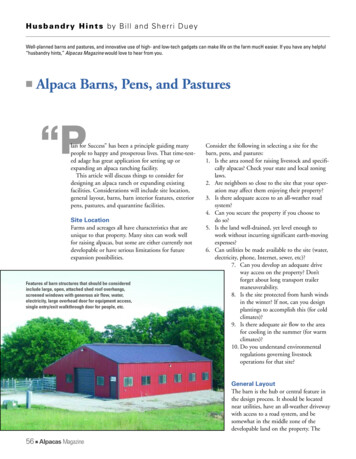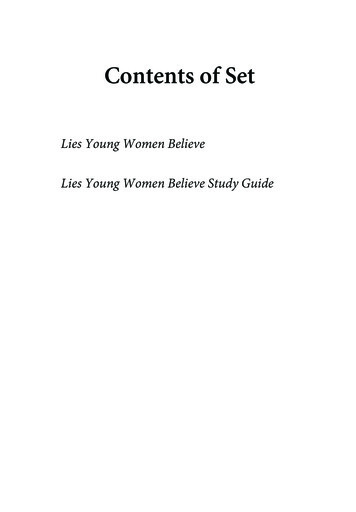
Transcription
Agricultural Issues CenterUniversity of CaliforniaJanuary 2006Alpaca Lies?Do Alpacas Represent the Latest Speculative Bubble in Agriculture?Tina L. SaitoneRichard J. SextonDepartment of Agricultural and Resource EconomicsUniversity of California, DavisSeptember 26, 2005Supported in part by the Agricultural Marketing Resource Center
Alpaca Lies?Do Alpacas Represent the Latest Speculative Bubble in Agriculture?Tina L. SaitoneRichard J. SextonDepartment of Agricultural and Resource EconomicsUniversity of California, DavisSeptember 26, 2005Abstract: Alpacas were introduced into the U.S. from South America in 1984, and the domesticalpaca herd has grown rapidly in the succeeding 20 years. The benefits of raising alpacas aretouted routinely on national television, and alpaca breeding stock in the U.S. sells routinely forprices in the range of 25,000 per head, many times higher than prices obtainable in Peru, wherethe world’s largest alpaca herd resides. We study the evolution of the U.S. alpaca industry andask whether today’s current prices for alpaca stock can be justified by fundamental economicconditions governing the industry, or whether alpacas represent the latest speculative bubble inAmerican agriculture.
Alpaca Lies?Do Alpacas Represent the Latest Speculative Bubble in Agriculture?The alpaca industry in the United States began when these camelids were first imported in 1984from South America. Since this time owners, breeders, and speculators alike have beenpromoting the industry, pushing for national herd expansion to facilitate a base of animalsadequate to sustain a viable alpaca textile industry. Touted in advertisements on nationaltelevision (e.g., see exhibit 1) as an alternative to the corporate lifestyle for average Americans,the U.S. alpaca herd has grown substantially over the past twenty years, with the stock ofregistered animals exceeding 62,000 at the start of 2004.1The average auction price of alpaca breeding stock in the U.S. may exceed 25,000 while inPeru, where over three million alpacas reside and the world’s only viable alpaca textile industryis maintained, alpacas sell for a small fraction of this price. The pricing dichotomy is even morestriking when considering that all U.S. alpacas are of South American origin and boast few, ifany, distinguishing characteristics from their ancestors.While Dutch tulip mania, the South Sea bubble, and the Mississippi bubble are on most shortlists of famous, speculative manias with dire consequences, the agriculture industry has not beenimmune to speculative bubbles. Merino sheep, Berkshire hogs, Broom corn, and Rohan potatoesare examples of commodities attracting speculation during the pre-Civil War period of U.S.history (Cole, 1926), while more recent bubbles have surrounded increasingly exotic specimenssuch as Emus, Shetland ponies, Boer goats, and ostriches (Gillespie and Schupp, 2002). Due tothe striking similarities between the auspicious beginnings of these industries and the U.S. alpacaindustry, it is important to consider whether alpacas represent the latest speculative bubble inagriculture.1Ohio, with 8,565 registered animals, is the leading state in the U.S. in terms of alpaca population followed byWashington, Oregon and Colorado, respectively (Alpaca Registry Inc., 2004).1
This paper investigates the evolution and current state of the alpaca industry in the U.S. andaddresses whether current alpaca prices are supportable by market fundamentals or, instead,likely reflect a speculative bubble that is destined to burst to the ultimate dismay of investorsswayed by the pervasive advertising campaigns and the animals’ appealing appearance. Mostspeculative bubbles throughout history have been studied from an ex post perspective, usingretrospection and econometric tests to assess whether market fundamentals or self-fulfillingspeculation determined the historical pattern of prices. This paper is a rare attempt to investigatea potentially ongoing speculative bubble. The practical benefit of this research is to advise thosewho are considering investments in alpacas. A more fundamental contribution is to examine thecircumstances that have led the U.S. alpaca industry to its present state and distill the lessons thatcan be distilled from it.Exhibit 1Alpaca Television Advertisement TranscriptActor/Alpaca Rancher: I love alpacas because back in 1993 I was getting burned out in ahigh-stress medical practice. I discovered that raising alpacas allowed me to live acomfortable rural lifestyle and to spend more time with my family. Now, 10 years later, I canstill say that it was a great decision.Announcer: Alpacas are gentle and easy to raise. To get the full story, visit an alpaca farm orranch. To locate one near you, go to Ilovealpacas.com.Advertisement transcribed from “On the Record,” Fox News Channel, August 24, 2005In the following sections, we describe the introduction of alpacas to the U.S. and examine thesubsequent growth of the industry. We discuss several barriers to entry that have been erected inthe industry and that effectively prohibit the importation of alpacas to the U.S. Subsequently, weinvestigate the market status of alpaca fiber, the sole marketable product produced by alpacas2
and, thus, the main source of their value, apart from the speculative value associated withbreeding stock.Based upon this foundation, we formulate a conceptual model to determine the capital assetvalue of an alpaca, following the seminal approach developed by Jarvis (1974), who designed alivestock valuation framework based upon animals’ essential characteristics as a capital good,with their current value as slaughter animals and future value in reproduction utilized todetermine the animals’ inherent worth. This model was extended subsequently to the valuationof animals whose worth is derived from byproducts such as draft power, milk, manure, and hide(Jarvis, 1982). We adapt the livestock capital asset framework to incorporate the unique featuresof alpacas, including their value as fiber producers. We ultimately combine the conceptual andempirical evidence to address and answer the fundamental question of whether contemporaryprices for alpacas in the U.S. can be explained by market fundamentals or are driven byspeculation and represent a bubble that is destined to burst.Evolution of the U.S. Alpaca IndustryFour years after the first alpaca was imported into the U.S. from South America, the AlpacaOwners and Breeders Association (AOBA) was established in 1988. Immediately uponinception, the AOBA created the Alpaca Registry, Inc. (ARI) to undertake blood typing, DNAtesting, and the registering of animals being imported into the U.S. Originally, any alpaca couldbe registered with the ARI regardless of its country of origin, but as time progressed and thepopulation of alpacas grew, the AOBA began expressing concerns surrounding the geneticintegrity and overall quality of the U.S. herd (Safley, 2004a). Consequently, screening processeswere instated and became increasingly stringent over time until the ultimate closure of theregistry in 1998 when the ARI began restricting registration to only those offspring (cria) of a3
registered sire and dam. As a consequence of the registry closure, all animals are now bloodtyped prior to registration in order to confirm their parentage. Currently, nearly 99% of allalpacas in the U.S. are registered, and animals in the U.S. without this distinction have minimalvalue as breeding stock or in auctions and are extremely difficult to sell via private transactions(Collins, 2000).Genetic integrity and quality of the U.S. herd were cited as the primary reasons for theclosure of the registry. According to Safley (2004b), pedigrees make alpacas more valuable andbecome increasingly important as a decreasing percentage of the national herd is withoutdocumented parentage. Opposition to the closure of the registry was based upon the belief thatthe gene pool in the U.S. is not large enough and that the closure limits and ultimatelycompromises the potential for genetic improvement in the herd. Individuals who contest theclosure argue that the most effective and judicious way to improve herd quality, and therebyfiber quality and confirmation, is, in fact, through imported genetics.Culling defective or less desirable traits from domestic animals through selective breeding isthe only option available in the U.S. as a result of registry closure. However, in an industrydominated by new and novice owners, herd improvement through culling and selective breedingmay be unrealistic to expect. First, novice owner/breeders are unlikely to be proficient at geneticmapping and selecting breeding stock to improve their herds. Second, given that most revenuesfrom alpaca production are generated through the sale of alpacas for new herds or expansion ofexisting herds, there is little incentive to not utilize the entire breeding stock, thereby expandingthe national herd as quickly as possible without regard to quality considerations. An alternativeto the dubious, genetics-based explanation for closure of the registry is that the registry wasclosed to create barriers to entry and effectively implement a supply restriction and, therefore,add value to alpacas conceived in the U.S. of registered parents.4
In addition to requirements surrounding the parentage and genetic integrity of all criaaccepted into the registry, the ARI prohibits the registration of cria conceived through“unnatural” methods such as artificial insemination and embryo transfer. These limitations onreproduction within the alpaca herd do little if anything to limit the growth rate of the domesticherd, which is determined primarily by the reproductive capacity of the adult females in the herd.However, the restrictions potentially create a broader market for herd sires to be used inreproduction.Male alpacas that are considered unsuitable as herd sires are castrated. These geldings or“fiber males” have lower testosterone levels, allowing them to produce better quality fiber forlonger periods of time then unaltered males. Therefore, the primary measure of a gelding's valueis the fineness, uniformity, and quantity of his fleece (Gardiner, 2005). While geldings tend to bemore accommodating to human interaction than breeding males and female alpacas, the “pet”market is extremely limited.Although the registration requirements and the closure of ARI represent a form of supplyrestriction and a barrier to the importation of alpacas, additional import restrictions are in placedue to disease concerns because Peru, which has endured outbreaks of foot and mouth disease(FMD) as recently as 2001, is not classified by the U.S. Department of Agriculture (USDA) as aFMD-free country.2 Peru’s FMD status precludes the importation of any ruminant from Peruinto the U.S.3 Chile is the only South American country with an alpaca population that iseligible currently to export ruminants to the U.S. Nonetheless, Chilean alpaca exports to the U.S.2FMD is a highly contagious viral syndrome that causes ruminants to contract blisters on their mouths, tongues,lips, and feet.3Although Peru and much of South America have never been characterized as FMD free, the alpaca herd in the U.S.is exclusively of South American origin due to the opportunity from 1979-98 to import livestock from countriesclassified as high disease risk through the Harry S. Truman Animal Import Center (HSTAIC) located in Key West,Florida. Of the 6,713 animals imported through the center over the 19 years that the facility was in operation, 5,046were alpacas (U.S. Environmental Protection Agency, 1998). Underutilization of HSTAIC forced its closure in1998, effectively prohibiting the importation of alpacas and all other animals into the U.S. from any country notcurrently classified as FMD free.5
have not been a factor due to the substantial costs, quarantine time, and risks associated withintercontinental trade in live animals, and, since 1998, their preclusion from the ARI.Furthermore, in 2003 the Canadian border was closed to the importation of all ruminants dueto Bovine Spongiform Encephalopathy (BSE) concerns, thereby eliminating the possibility ofimporting alpacas to the U.S. from the north.4 While Canada’s alpaca population is smallrelative to that of the U.S., this additional restriction ensures that progressively higher alpacaprices in the U.S. cannot attract importation and cross-country arbitrage from the North or theSouth.5Although they are not presently binding in the U.S. due to the aforementioned FMDconcerns, barriers to the exportation of alpacas have been imposed by the Peruvian government,which regards the animal as a national symbol. Prior to 1990, alpacas could not be exportedfrom Peru due to stringent government regulations surrounding the animal. Under AlbertoFujimori, the Peruvian government began to allow limited exporting of alpacas, hoping tosafeguard against the establishment of significant herds in other parts of the world which couldthreaten their domestic fiber industry. Since 1997, Peru has allowed the exportation of only3,308 alpacas (Gil, 2005).Due to this export quota, the smuggling of alpacas from Peru through Bolivia and, ultimately,to Chile has become an issue. Reportedly, Chile exports nearly 4,000 alpacas per year (AlpacaPeru, 2004), despite having a domestic alpaca population of only 30,000 head. Individuals arereportedly able to buy Peru’s premiere alpacas for sometimes less then 100, smuggle them4Although alpacas have multiple stomachs, meeting the definition of a ruminant utilized by the USDA, the riskassociated with their importation is minimal as alpaca meat is not consumed in the U.S. and there have been nodocumented incidences of BSE or scrapies, the equivalent of BSE in sheep, in alpacas.5The mutual presence of these dual entry barriers makes it impossible to determine the effect of the registry closureon the price of alpaca breeding stock in the U.S., leaving unanswered the question of whether closure of the registrycould be effective in restricting supply in the absence of the importation limitations imposed by the U.S.6
through Bolivia and into Chile, where they can be exported at prices ranging from 15,000 to50,000 dollars (Alpaca Peru, 2004).6Table 1 provides an indication of the U.S. alpaca prices that have been generated as aconsequence of the confluence of the economic factors affecting the U.S. industry. There is nosystematic public reporting of alpaca prices, so table 1 represents a survey of over 900 auctionprices collected by the authors. Although the table evinces considerable variation in the salesprices of alpacas, even the lowest prices recorded at the auctions surveyed were several thousanddollars, with average prices in most cases exceeding 25,000, and with prices exhibiting a cleartendency to rise during the four-year period surveyed. Although we cannot attest that the pricesreported in the table are a representative sample, they are broadly consistent with the informationthat AOBA provides to potential investors—the acquisition cost of an average female is between 12,000 and 25,000 while the price for an average herd sire could fall in the range of 20,000 50,000 (AOBA, 2004).6Because nearly half of Peru’s alpaca population resides in Puno, near the Bolivian border, smuggling animals fromthese locations is relatively easy.7
Table 1. Alpaca Auction Price Statistics200116,910.474357,7503,90020022003All prices are in U.S. dollarsaTotal 6,00016,866.672734,1007,200Total 26,700557,75010,000Huacaya w15,622.373848,4003,900Huacaya ,00024,443.0714880,0006,000Suri geObservationsHighLow17,265.222334,1007,200aSuri 9,8257268,00011,500Huacaya and suri are the two major types of alpacas in the U.S. See the main text for further discussion.The following auctions were surveyed to compile the data in this table: 2004—America’s Choice Alpaca S(ACAS) , Breeder’s Showcase Alpaca Sale (BCAS), Mapaca Jubilee Alpaca Sale, AOBA Alpaca Sale(AOBA-AS); 2003-- ACAS, Celebrity Alpaca Sale (CAS), AOBA-AS, Parade of Champions Alpaca Sale,Breeder’s Choice Alpaca Sale (BCAS); 2002- ACAS, CAS, AOBA-AS, Accoyo Alpaca Sale (AAS), BCAS,2001-- Spring Celebration Alpaca Sale, AOBA-AS, BCAS, AAS.8
The Domestic and International Alpaca Fiber IndustrySouth Americans first domesticated alpacas centuries ago in order to utilize their fiber, and Peru,with the largest alpaca population in the world, is also the leading alpaca fiber and textile productexporter. The three plus million Peruvian alpacas produce over 4,000 tons of fiber annually,nearly 80% of all alpaca fiber production in the world (Vega, 2002).Through evolution in the extreme climate of the Andes, alpacas have acquired a fleece thatdoes not retain water, protects against solar radiation, and guards against extreme temperaturevariations.Present-day alpacas’ coats are almost exclusively fleece whereas beforedomestication they possessed much more guard hair, which is coarse and undesirable for textileproduction. Alpaca fiber is fine, smooth, soft, and can easily be dyed virtually any color desired.Alpaca fiber contains microscopic air pockets which provide excellent insulation.Further,alpaca fiber does not contain lanoline and consequently few individuals are allergic to the textilesproduced.Sheared annually, the average alpaca produces between 6 and 8 pounds of raw fiber per year.Alpaca fiber prices are determined primarily by two specific criteria: micron count and the typeof alpaca (huacaya or suri) producing the fiber.7 The higher the micron count of the fiber, thecoarser the yarn and the lower the quality of the ultimate textile product produced.8Consequently, processors pay a premium for fiber with lower micron count. Micron count andthe weight of the fiber are inversely proportional, a quintessential trade off between quality andquantity. The age of an animal is inversely related to both the quality and quantity of its fiber.Tuis, alpacas 18-24 months old that have yet to have their first shearing, are believed to produce7Huacaya alpacas comprise over 80% of the alpaca population in the U.S. and produce short, crimped fiber. Surialpacas are more rare and earn a premium for their fine, lustrous fiber which resembles long mohair.8Until recently, fiber quality in Peru was discerned through feel or “handle”. However, use of laser scanningtechnology to determine fiber quality has become established in the U.S., and Peruvian processors are nowbeginning to incorporate these more objective standards to determine prices.9
the highest quality fiber. As the animal ages, its fiber becomes coarser, causing quality todecline.Micron count is also a function of the inputs available to the animal and a host ofenvironmental factors. High-protein feeds and supplements may increase the quality of the fiber,while adverse environmental situations such as transportation, stress, pregnancy, etc., canincrease micron levels diminish fiber quality.Revenues from the Sale of Alpaca Fiber in North AmericaThe market for alpaca fiber in North America has been limited due to lack of large-scaleprocessing facilities. To date, revenue generated from the sale of alpaca fiber in North Americaemanates primarily from two sources: small-scale (cottage), independent textile producers or theAlpaca Fiber Cooperative of North America (AFCNA). The AFCNA was established in 1998with the goal of pooling members’ fiber in order to be able to sell fiber in bulk, mitigate costs,and increase participation in value-added textile markets. The lack of processing facilities in theU.S. has forced AFCNA to utilize processors in South America, despite the significanttransportation costs associated with such outsourcing. 9According to Kara Heinrichs (2004), President of the AFCNA, reputable producers withestablished contacts in the niche textile markets can obtain upwards of 44/lb. for raw fiber ofbaby or royal baby quality (a micron count of 22.9 or less). Yet, it is widely accepted within theindustry to be virtually impossible to sell raw fiber in any significant volume, at these prices.The growing number of fiber-producing animals in the U.S. has essentially saturated this nichemarket demand, forcing most producers to seek alternative outlets for their clip. Consequently,9AFCNA fiber has been processed in Peru for as little as 9/lb, substantial cost savings, relative to prices chargedby U.S. mills, which more then covers the shipping and customs costs. Yet AFCNA withheld the 2004 clip to beprocessed with that collected in 2005 in hopes of processing it exclusively in the U.S. and marketing products madefrom this fiber under a North American Alpaca Trademark.10
many have turned to the AFCNA to process and market their fiber. AFCNA members receiveanywhere from 5.00/lb. for royal-baby-quality fiber to 0.50/lb. for short or coarse/strong fiber(AFCNA, 2004). In addition, a premium of nearly 2.50/lb. has been paid for high-quality fiberproduced by suri alpacas.Although the AFCNA prices are above the prices paid for raw fiber in the world market, theyare significantly less then prices reportedly paid by cottage-industry textile producers. 10Additionally, AFCNA patrons do not receive payment in cash but, rather, through credits at thecooperative store. The cooperative’s path since its inception has been rocky, and it has yet to turna profit or pay patronage dividends to members, suggesting that even these prices are notsustainable without cost reductions or improvements in the fiber market.Costs of Production for Alpaca FiberThe AFCNA (2005) estimates that the feeding, vaccination and general health requirements ofthe average alpaca raised in the U.S. are approximately 169 annually (about 26/lb. of fiberharvested annually). We derived an independent cost estimate by surveying the veterinaryliterature (e.g., Van Suan, 1999 and Purdy, 2004) and various industry publications regarding thenutritional requirements for camelids in North America. Based upon a simple and modestfeeding regime with a focus on minimizing costs, we estimate that feeding requirements for anaverage alpaca are about 208 annually at current input prices. In addition, alpacas must also bewormed and vaccinated to maintain adequate health and ability to produce quality fiber. For anaverage-sized alpaca, annual worming and vaccination costs total nearly 100.Thus, weestimate that it costs approximately 308 per year ( 47/lb. of fiber harvested) to provide proper10World market prices as recently as 2002 reflected no premium for suri fiber and the maximum price paid for anyquality fiber (white royal baby) was 3.80/lb. in U.S. dollars (AFCNA, 2005). Consequently, the AFCNA reportspaying its members a premium of 4.70/lb. and 1.20/lb. for suri and huacaya fiber, respectively.11
nutrition and veterinary care for an alpaca. Details on our cost estimates are provided in theAppendix.Profitability AnalysisBased on AFCNA’s conservative estimate of production costs, the price of unprocessed fiberwould have to be nearly 26/lb. for alpaca breeders to cover variable production costs from fiberrevenues, but even those raising suri alpacas and producing the highest-quality fibers arereceiving only on the order of 7.50/lb. from AFCNA. Based upon our cost estimates, raw fiberprices would have to increase to 47/lb. for breeders to cover the variable costs associated withmaintaining their herds.The situation is more promising for breeders who are able to sell alpaca fiber to cottageindustry textile producers instead of AFCNA. Based upon the estimated value paid by cottageindustry textile producers of 44/lb. for raw fiber, a producer would earn a variable profit peranimal (net of harvest costs) from fiber sale of 92 based upon AFCNA’s costs or a per-animalloss of 47, based upon our cost estimate. Thus, by utilizing reported revenues from sales to theniche cottage milling sector and conservative estimates of production costs, it is possible togenerate some scenarios where fiber sales generate per-animal revenues in excess of per-animalvariable production and fiber-harvest costs. However, it is worth reiterating that cottage industrytextile producers represent an extremely limited niche market and do not collectively demand alarge portion of the industry’s fiber even at its current size.11 Instead the typical producer must11Clearly the reported prices for sales to the cottage milling industry must be viewed with some circumspection.Given that a large share of U.S. production is apparently selling for a small fraction of these prices, and fiber can beimported from Peru at a considerably lower cost, it is not clear why rational millers would pay these premium prices.12
sell through the AFCNA, where the implicit revenue obtained through store credit does notremotely remunerate even the most conservative estimates of alpaca production costs.12Although the preceding analysis is not sanguine regarding the opportunities to cover thevariable costs of raising alpacas through the sale of alpaca fiber, it is, nonetheless, too optimisticbecause the revenue estimates have assumed that (i) all fiber produced is royal baby, (ii) alpacasproduce a uniform fiber quality, and (iii) other costs such as shipping and insurance areinsignificant.13 In reality, the fiber clip from any animal is not of uniform quality. Only about60-70% of the clip from an animal (the blanket, neck, and middle legs), or 3.6 to 5.6 pounds, canbe sold as quality fiber. The remaining portions of the clip (lower leg, belly, britch, and apron)can be sold for a lesser price if they have a micron count less then 31.9 and are not matted orstained.Statistics reported by the AFCNA (2005) confirm that significant quality heterogeneity existsin U.S. alpaca-fiber harvest. Only 1-2% of total past clip collections have been of royal babyquality and an additional 4-8% were of baby quality. Therefore, at most 2% of the total U.S. clipharvested would be valued at 7.50/lb. (suri) and 5/lb. (huacaya). As much as 66% of all fibercollected by AFCNA is either superfine (23-26.9 micron count) or adult (27-31.9 micron count)quality, which are valued by AFCNA at only 3/lb. and 1/lb., respectively, for huacaya fiberand 4.5/lb. and 1/lb., respectively, for suri fiber. Table 2 summarizes the cost and revenueanalysis, including the optimistic scenario involving sale to independent textile producers and12Another possible fiber-marketing strategy for alpaca owners is to procure custom fiber processing and sellprocessed fiber to independent textile producers. We gave little consideration to this strategy because we foundlittle information on it, and, more importantly, because processing is unlikely to be an activity that generateseconomic profit for alpaca owners. Alpaca owners would have no advantage relative to textile producers inobtaining processing services, and, thus, willingness of buyers to pay for processed fiber relative to raw fiber shouldnot exceed the full cost of procuring processing services.13Shipping costs are a function of volume and distance shipped and will vary across producers. We have no goodestimates for shipping costs, but their omission causes our and AFCNA’s cost estimates to be understated ceterisparibus. Similarly our information suggests that most producers insure their animals. Average insurance rates are3.25% of the value of the animal (AOBA, 2004).13
more realistic scenarios involving a mix of fiber quality and sales at the prices paid by theAFCNA. Notably under the more realistic scenario, the value of a huacaya’s fiber does not coverthe variable costs associated with harvesting it.Table 2. Revenue and Cost of Fiber ProductionIndependentProducerSuriAFCNA MemberSuriHuacaya5 lbs Baby6.5 lbs. Royal Bab6.5 lbs Royal Ba1.5 lbs Adu6.5 lbs RoyBabyHuacaya5 lbs Baby1.5 lbs AdulRevenue from 8255.98255.98255.98Net Revenue From Fiber26117.770.521.52-9.48Variable Cost (authors)Variable Cost 69Profit From Fiber (authorsProfit From Fiber 167.48-317.33-178.48International Trade in Alpaca Fiber and TextilesAlthough barriers to international trade in live alpacas are multiple and, for the short term,apparently immutable, trade barriers for alpaca fiber have been virtually eliminated.InDecember 2001, the Andean Trade Preference Act (ATPA) expired and prompted passage theAndean Trade Promotion and Drug Eradication Act (ATPDEA). According to the Office of theUnited States Trade Representatives (USTR) (2003) “the objective of both laws has been topromote broad-based economic development, diversify exports, consolidate democracy, anddiscourage drug trafficking by providing sustainable economic alternatives to drug-cropproduction in Bolivia, Columbia, Ecuador and Peru”. Whereas under the ATPA only fourPeruvian commodities (copper, asparagus, jewelry and zinc) received trade duty and quota14
exemptions, with the revision over 6,000 products became eligible for various types of traderegulation exemptions.Prior to passage of the ATPDEA, Peruvian textile producers were subject to tariffs of over 21percent in many cases. According to the USTR (2003), “the National Society of Industriesestimates that the la
the U.S. alpaca herd has grown substantially over the past twenty years, with the stock of registered animals exceeding 62,000 at the start of 2004.1 The average auction price of alpaca breeding stock in the U.S. may exceed 25,000 while in Peru, where over three million alpacas reside and the world's only viable alpaca textile industry
